My experiment with a $4-a-day budget has become a welcome and permanent adjustment to my menu planning and grocery shopping routine. It has saved not only money, but my time as well as some of my sanity. The $4 a day food budget was popularized by Leanne Brown in her free online book, Good and Cheap (PDF), written primarily for those using SNAP (food stamp) benefits. (Editor’s note: In 2023, that $4 a day budget would have risen to $6.29 a day — still a bargain.)
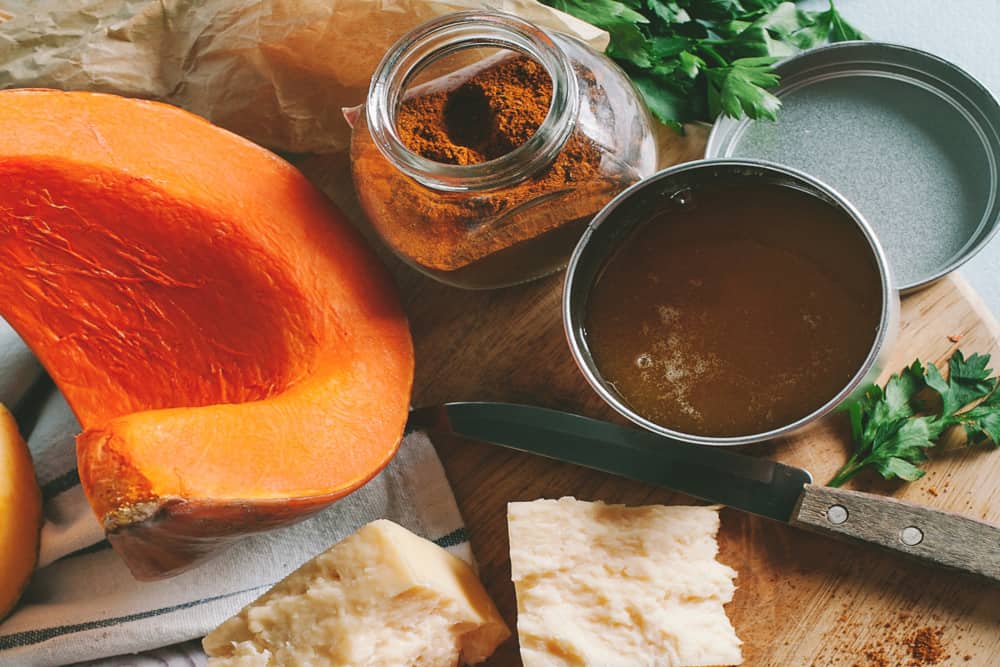
Even though I used to spend nearly three times as much ($12 a day), I’ve greatly enjoyed the changes I’ve had to make to achieve the $4 a day mark, and see no reason to return to … whatever I was doing before. I spend much less time stressing over menu planning, grocery shopping and meal preparation. Further, mealtimes are enjoyable like never before. Every meal has become a repast filled with comfort food.
To accomplish these changes, I’ve adopted a weekly rotation of favorite dishes that includes tacos, pasta, stir-fry, burgers and other adaptable recipes. Each week, I prepare more or less the same recipes, but vary the ingredients based on what I’ve purchased that is most economical. What follows are recipes and menu ideas that you can adopt, or use as a springboard to customize your ideal menu and food budget plan.
Sunday: Roast or braised meat or poultry
My “food prep week” starts on Sunday with a meal of roasted or braised meat, which can be served with a grain and vegetable pilaf, potatoes and salad, or any other available accompaniments that sound good. Since I typically buy only the cheapest cuts of meat, braising works well for choices such as beef chuck and pork shoulder. Slice, shred, or chop leftovers to be used in the next week’s recipes.
Bone-in meats are the most economical, especially if you simmer the bones later to make a nourishing broth. Save bones in the freezer from roasted or braised meat or poultry dishes and make bone broth when you have enough bones and the time to make it (true bone broth needs 24-48 hours of simmering time).
Basic recipe for roast chicken. Sprinkle the inside of a 4-5 pound chicken with salt and pepper, then stuff it with 2-3 bay leaves (I have a plant in my yard—you can also use oregano or thyme or skip this step if it’s too expensive for your budget) and half a sliced large yellow onion. I smear the outside with 1-2 tablespoons butter (or oil … but using nothing works, too) and sprinkle it with salt and pepper. I cut the remaining onion in thick slices, put it in a roasting pan and plunk the chicken on top of it.
I put the pan in a 450°F oven and roast the bird for 75 minutes, or until it tests done. While you can get fancier with more vegetables, herbs, lemons or other ingredients, this method turns out juicy, well-flavored meat on a budget.
Basic recipe for braised beef, pork, or stewing hen. Preheat the oven to 325°F. In a large Dutch oven, heat the 2 tablespoons oil over medium heat and brown meat on all sides (2 pounds meat such as beef chuck, pork shoulder, or bone-in chicken pieces…or stewing hen if you can get it). Add 2 chopped medium onions and 2 cloves minced garlic and cook a few minutes until softened. Sprinkle meat and onions evenly with 1 teaspoon each salt, oregano, ground coriander or cumin seed, and chili powder or cayenne pepper.
Pour one cup liquid over everything (water, broth, apple juice, or beer may be used). Bring to a simmer, cover and bake at 325°F for 2-3 hours, or until meat falls apart. This recipe can easily be doubled or re-doubled for larger amounts.
Basic recipe for bone broth. For every 1 pound of bones, use two quarts water. Vegetables are not necessary, just a small amount of salt and 1-2 whole garlic cloves provide good flavor. But feel free to add trimmings from onions, carrots, celery, mushrooms, or herbs (even parsley stems) if you have them on hand, and increase the water to cover everything by an inch or two.
Simmer at least 8 hours, but for true bone broth, simmer 24 hours for poultry bones and 48 hours for meat bones (beef, pork, lamb). It is important that the broth simmer very quietly, with “movement” of the liquid, but no bubbles (or rarely) breaking the surface; keep the heat very low and simmer the broth very slowly. Add additional water if needed, every several hours.
Properly made, the nutritional benefits in bone broth include calories, protein, and minerals. Strain and thoroughly chill the broth. If you won’t drink it within three days, freeze it in 1-2 cup portions. Reheat bone broth in the microwave and sip as a nourishing refreshment, or use bone both like you would stock when you make soup or stew.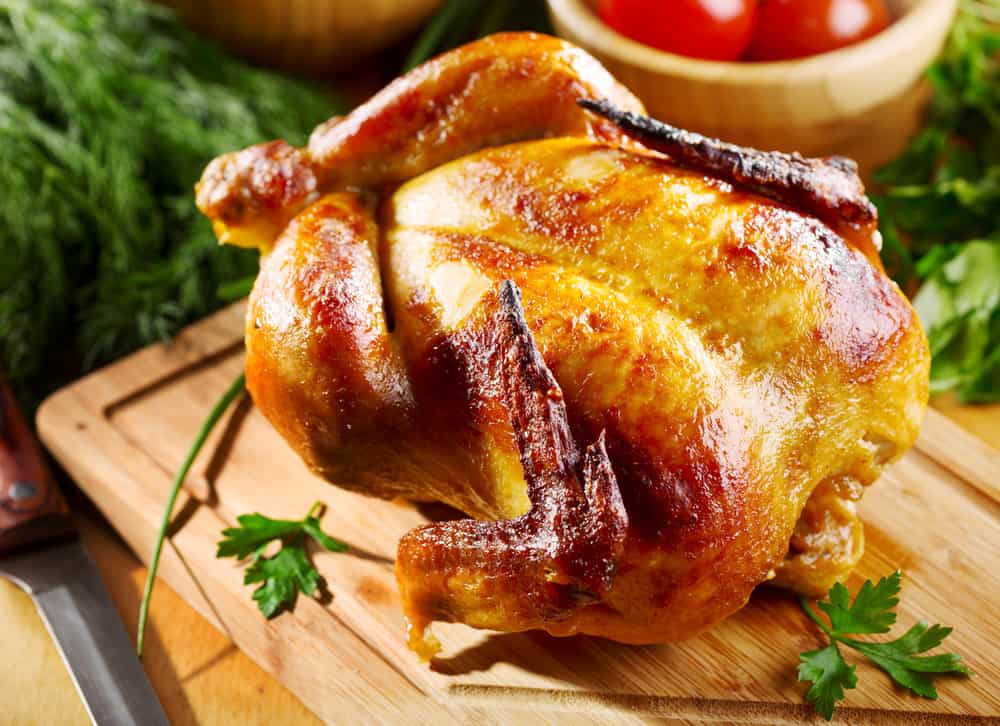
Monday: Stuffed vegetable recipe ideas
Stuffed vegetables are easy to make and adapt to a wide variety of seasonal ingredients. The basic idea is to fill vegetables with a grain and vegetable pilaf and bake until piping hot. Most stuffed vegetables freeze well, reheat in the microwave, and many are also good served cold. So when you find a recipe your family likes, be sure to make a double batch.
Classic vegetables for stuffing include hollowed-out halves of zucchini, acorn squash, eggplants or plantains. Many other vegetables can be stuffed, including cabbage leaves, sturdy green leaves (kale, chard, and collards), stemmed large mushroom caps, and hollowed-out green or red peppers, tomatoes, and onions. Any of these vegetables can be filled with a well-seasoned pilaf containing cooked grain and beans with diced vegetables, perhaps enhanced with cheese or a sauce. Here’s a basic recipe, followed by a list of suggested variations.
Basic stuffed vegetable recipe (per person): One vegetable for stuffing (hollowed out zucchini halves or tomato, cabbage leaves, etc.). A seasoned pilaf: 1/2 cup cooked grain, 1/2 cup vegetables, 1/4 cup cooked or canned (drained) beans, and seasonings to taste. If desired, any cooked meat or seafood may also be incorporated into the filling. Stuff vegetable with filling. Drizzle with oil or top with grated cheeses or tomato sauce, cover and bake at 350°F for 30 minutes or until hot. Here are some stuffed vegetable recipe ideas:
Zucchini boats with rice pilaf and tomato sauce. Rice pilaf: cooked rice, frozen peas and diced carrots, and black beans; seasoned with chopped fresh parsley, salt, and pepper. Top stuffed zucchini with 1 tablespoons tomato sauce and sprinkle with crumbled feta cheese.
Red bell pepper with quinoa pilaf and jack cheese. Quinoa pilaf: cooked quinoa, corn and diced tomato, pinto beans, and diced jalapeno pepper or green chiles to taste; seasoned with salt and pepper. Sprinkle stuffed pepper with jack cheese.
Eggplant with barley pilaf and yogurt sauce. Sprinkle hollowed out eggplant shells with salt and invert on a paper towel to extract excess moisture and any bitterness. Chop scooped-out eggplant and sauté with a small amount of oil and chopped garlic until browned lightly. Barley pilaf: cooked barley, cooked eggplant, diced pepper or tomato, and red beans, seasoned with salt, cumin, and pepper. Served stuffed eggplants with yogurt seasoned with chopped fresh cilantro or mint, salt, and black pepper.
Onion with tabbouleh and cucumber sauce. Sauté scooped-out onion and diced cooking greens (kale, collards) in oil until softened. Tabbouleh (bulgur wheat pilaf): cooked bulgur, cooked onions and greens, diced green onion and chopped mint or parsley, and white beans, seasoned with salt and pepper. Drizzle with oil before baking. Serve stuffed onions with cucumber sauce (tzatziki) made with 1 diced cucumber (peeled and seeded) and 1 cup plain yogurt, seasoned with minced garlic, lemon juice, salt, and pepper.
 Tuesday: Taco filling ideas
Tuesday: Taco filling ideas
Tex-Mex style tacos are made with a crispy corn or soft flour tortilla filled with seasoned ground meat and garnished with shredded lettuce, chopped tomatoes, and cheddar cheese. However, if you’re willing to branch out, there are many other delicious “street tacos” containing shredded or grilled meats or fish and seasonal vegetables that are often more economical. Here are a few seasonal, “street taco” ideas:
Shredded beef with avocado and tomato slices, cilantro leaves, and cotija or feta cheese with a squeeze of lime juice
Shredded pork with grilled pineapple slices, onion slices pickled in vinegar, and fresh cilantro leaves with chipotle sauce
Shredded chicken with a slaw of thinly sliced green cabbage, red onion, and serrano chile with tomato salsa.
Grilled fish (e.g. tilapia or cod) with thinly sliced red cabbage, sweet onion, carrot, and fresh cilantro leaves with Mexican crema (sour cream or yogurt may be substituted).
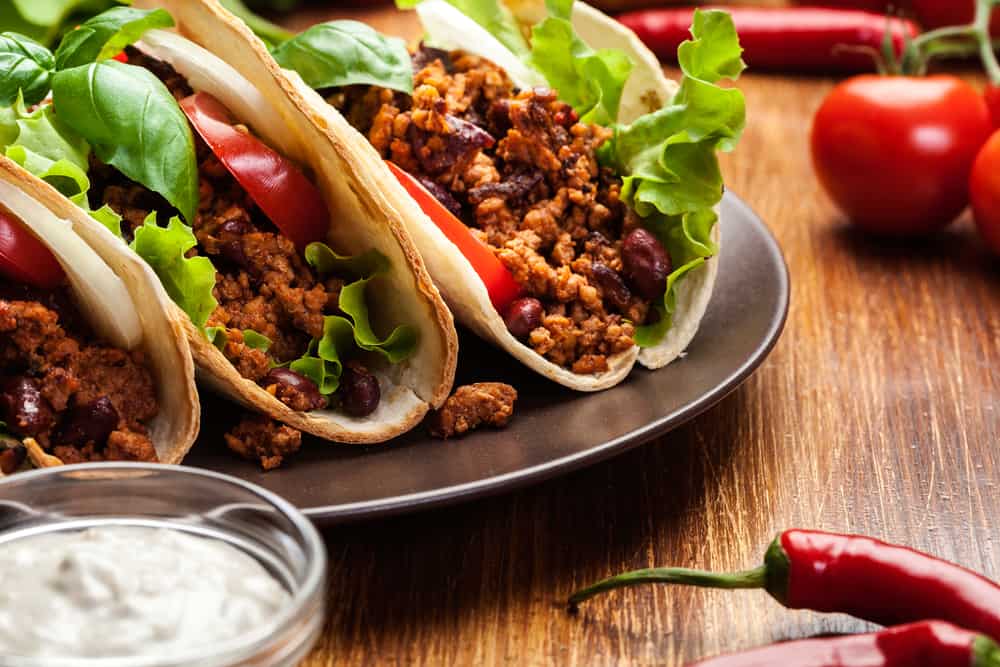
Wednesday: Pasta recipes
These four pasta recipes are popular classics that deserve to be in your repertoire, if they’re not already. They’re easy, delicious, budget-friendly and highly adaptable.
Spaghetti with quick tomato pasta sauce (makes about 1 quart or 4 servings). Pasta sauce you make yourself is easy, economical and delicious. In a medium saucepan, heat 2 tablespoons oil over medium heat. (If you want a meat or mushroom sauce, brown 1 pound ground meat, sausage or chopped mushrooms before you add garlic.) Add 2 cloves minced garlic and cook 1 minute or less, just until the aroma is released.
Add one 28-ounce can crushed tomatoes and one 14- or 15-ounce can tomato sauce, ½ teaspoon salt and ¼ teaspoon black pepper. (Optional: add 1 teaspoon dried oregano.) Bring to a simmer, reduce heat, cover, and simmer for 20 minutes. Serve over cooked spaghetti noodles. Recipe may be doubled or re-doubled and sauce may be frozen.
Mac and cheese (4 servings). Boil 8 ounces shaped pasta (shells, elbows, fusilli, or farfalle/bow ties, etc.) until al dente. In a saucepan, melt 2 tablespoons butter over medium heat. Stir in 2 Stir in 2 tablespoons chopped onion and cook for 2 minutes. Stir in 2 tablespoons flour and stir for 2 more minutes to cook the flour. Slowly whisk in 2 cups (any type) milk, stirring constantly until sauce thickens and boils. If you wish to include meat or fish, add cooked chopped meat or fish after the sauce comes to a boil.
Remove from heat and stir in 8 ounces (2 cups) shredded cheddar cheese or a combination of cheeses (sharp cheddar, gruyere, asiago, fontina, parmesan, blue…), and stir until cheese is melted and sauce is smooth. Stir in the drained pasta and serve immediately, or transfer to a buttered casserole dish, sprinkle with buttered breadcrumbs and bake at 350°F for 20-30 minutes, or until hot and bubbly.
Pasta primavera with seasonal vegetables (per person). Usually made with spring vegetables, this adaptable dish works with many kinds of vegetables. Boil 2 ounces shaped pasta (ziti, rigatoni, penne, etc.), until al dente. Slice 1-2 cups vegetables (such as carrots, peppers, onions, zucchini, mushrooms, broccoli, cherry tomatoes, etc.). Sauté vegetables in hot oil for 8-10 minutes, or until tender. If you wish to include meat, add cooked shredded meat after vegetables are tender. Add 1/2 cup pasta cooking water or plain water and drained pasta; toss until well combined. Season to taste with salt and pepper. Turn off heat and sprinkle with grated parmesan cheese before serving.
Pasta with clams or seafood (per person). Boil 2 ounces fettuccine or linguine until al dente. Sauté 1/4 of a sliced onion, 1 clove minced garlic and crushed red pepper flakes in hot oil for 2 minutes, or until just beginning to soften. Add 3 ounces (1/2 small can) clams (or other seafood or fish) with their liquid and 1/2 cup white wine or water. Bring to a simmer. Add cooked fettuccine and toss until well combined. Season to taste with salt and pepper. Turn off heat and sprinkle with grated parmesan cheese and freshly chopped parsley before serving.
Other fast, easy pasta skillet recipes include puttanesca, carbonara (with egg and bacon), peas and ham, spinach and ricotta, and pesto with salmon.

Thursday: Stir fry or salad
Make stir fry during cold weather and salad when it’s hot. Here are a couple classic recipes to get you started.
Basic Chinese-style noodle stir-fry (per person). This adaptable dish works with many kinds of vegetables. Slice 1-2 cups vegetables (broccoli, cabbage, carrots, mushrooms, onions, bell peppers, water chestnuts, bamboo shoots, etc.). Include 1 teaspoon each minced ginger and garlic. Sauté vegetables, ginger, and garlic in 1 tablespoon hot oil for 8-10 minutes, or until tender. If you wish to include meat, add cooked shredded meat after the vegetables are tender.
Make a sauce: stir together 1/3 cup water, 1 tablespoon soy sauce, 1-2 teaspoons brown sugar, and 1 teaspoon cornstarch. Pour sauce over vegetables (and meat), add 2 ounces cooked and drained wheat or rice noodles, and toss until evenly mixed. Season to taste with salt, black or red pepper, and toasted sesame oil.
Basic Chinese-style fried rice (per person). Slice 1-2 cups vegetables, ginger, and garlic as for stir-fry. Sauté vegetables, ginger, and garlic in 1 tablespoon hot oil for 8-10 minutes, or until tender. (Optional: Make a well in the center of the vegetables and add 1 beaten egg. Stir mixture until egg is partially cooked.) Add 1 cup cooked rice and toss for 1 to 2 minutes, or until well-combined. Sprinkle with soy sauce, ground pepper, and toasted sesame oil. Stir until well-combined and steaming hot. Sprinkle with sliced green onion and serve immediately.
Classic American “chef” salad (per person): Prepare 1-2 cups mixed salad greens. Toss greens with 2-4 tablespoons salad dressing (Thousand Island, Ranch, vinaigrette, blue cheese, etc.). Arrange over dressed greens: 1/2 cup sliced deli meats (ham, turkey, bacon bits) and 1/4 cup shredded cheese (cheddar, Swiss, etc.). Decorate salad with chopped tomato and hard-cooked egg.
Italian chop salad (per person): Prepare 1/2 to 1 cup mixed salad greens and/or cabbage and 1/2 to 1 cup diced vegetables (zucchini, tomato, green beans, peas, corn kernels, carrots, bell peppers, sweet onion, fresh basil leaves, olives, artichoke hearts, pepperoncini or pickled peppers), 1/2 cup cooked grain (e.g. rice or bulgur) or shaped pasta (shells, rigatoni, etc.), and 1/4 cup cooked or canned (drained) beans such as garbanzo or kidney. If desired, add 1/2 cup sliced salami, cooked meat, or seafood, as well as 1/4 cup cheese (e.g. grated parmesan or mozzarella, or crumbled feta or blue cheese).
Toss ingredients together in a large bowl until combined. Drizzle salad with 2-4 tablespoons olive oil and vinegar or salad dressing (Italian vinaigrette, blue cheese, ranch, etc.) and toss again until ingredients are evenly coated.

Friday: Seafood recipes
There are plenty of seafood recipe ideas in the preceding recipes: fish tacos, fettucine with clams, shrimp fried rice, and seafood salad. But here is one more seafood recipe to round out your menus.
Seafood croquettes (makes 2 servings): In a medium bowl, mix together one 6- or 7-ounce can flaked seafood (tuna, salmon, crab), 2 chopped green onions, 2 teaspoons Dijon-style mustard, 1 beaten egg, 1/4 cup bread crumbs, 1/2 teaspoon salt, and 1/4 teaspoon pepper. Divide the mixture into two rounds and refrigerate for 15 minutes. Place 1/2 cup bread crumbs on a pie plate. flatten one of the rounds into a patty, place on the plate and press breadcrumbs into the patty on all sides. Repeat with the remaining seafood patty.
Heat a thin film of oil in a skillet over medium heat. Cook croquettes for 2 to 3 minutes on each side or until golden brown. Serve with rice or potatoes and salad or cole slaw; or use as a patty in a seafood burger.

Saturday: Burger recipes
Instead of ground meat burgers, make barbecue burgers with shredded braised meat (beef, pork, or chicken) moistened with barbecue sauce and reheated in a saucepan. Dress barbecue burgers with a seasonal slaw of shredded vegetables dressed with a little oil and vinegar. Sloppy Joes make another family-friendly meal that helps you stretch your meat dollar. Or go meatless on burger night by preparing bean burgers. Use any type of cooked or canned and drained beans: black, white, kidney, pinto or chickpea or canned black and pinto beans. Bean burgers freeze well, so make a double batch.
Sloppy Joe recipe: For 4 servings, brown 3/4 to 1 pound of ground meat (beef, pork, lamb, chicken, or turkey). Add 1/2 of a large bell pepper and 1/4 of a large onion, chopped. Make a sauce by stirring together 1/2 cup water, 1/2 cup ketchup, 2 cloves chopped garlic (or 1/4 teaspoon garlic powder), 1 tablespoon brown sugar, 1 teaspoon chili power, and 1/2 teaspoon dry mustard (or 1 ½ teaspoons prepared mustard). Add to taste any of the following: hot sauce, Worcestershire sauce, salt, and black pepper. Stir sauce into the meat and onions, cover and simmer 20 minutes. Serve sloppy joe meat like you would a burger, in a bun and dressed with seasonal slaw or vegetables.
Basic recipe for bean burgers (4 servings): In a medium bowl, coarsely mash 1½ cups (or one 15-ounce can) drained beans (any variety, black, red, white, etc.) using a potato masher or a fork. Mix in 2 tablespoons chopped fresh or pickled jalapeño, 1 cup chopped onion, and 1/4 cup bread crumbs. The mixture should be moist but not too loose and hold together when formed into a ball. If the mixture is too soft, add more breadcrumbs to get a good consistency. Taste and add salt as needed; homemade beans usually need 1 teaspoon salt; canned beans usually need none.
Divide mixture into four portions. Roll each portion into a ball and then flatten into a burger. Place 1/2 cup breadcrumbs on a large plate and each patty by flipping it over in the breadcrumbs and pressing lightly. Place crumb-coated burgers in one layer and refrigerate burgers until well chilled, at least 30 minutes or up to 1 day. Heat a thin film of oil in a skillet over medium heat. Cook bean patties for 3-4 minutes on each side or until heated through. Serve bean patties like you would any burger, in a bun and dressed with seasonal slaw or vegetables.

Use any or all of these ideas as a springboard to develop a weekly rotation of favorite dishes suited to budget menu planning and meal preparation. Choose recipes that allow you to vary ingredients based on what is most economical in any given grocery shopping trip. I hope you find, like I did, that $4 a day meals can come from a comfortable and satisfying food budget planning routine.
Learn more about $4-a-day budget meal planning:
- 18 strategies for $4-a-day budget meal planning and grocery shopping
- Customizable grocery shopping list for $4-a-day food budget
Learn more about budget-friendly cooking & family meals:
- The secret to serving a quick, cheap family dinner every night
- Freezer cooking 101: the key to healthy family dinners without the hassle
- Slow cooker meals for busy moms and dads
Learn more about meal planning:
- Freezer cooking 101: the key to healthy family dinners without the hassle
- How to find recipes for cheap, tasty meals
- One chicken, four meals
Learn more about saving money on groceries:
- Customizable grocery shopping list for $4 a day food budget
- Less extreme coupon strategies save money and time
- Earn cash by using the Ibotta app when you shop
- How to save money on food without using coupons
- Secrets to saving at high-end food stores
- Cheap and healthy food to eat on a budget
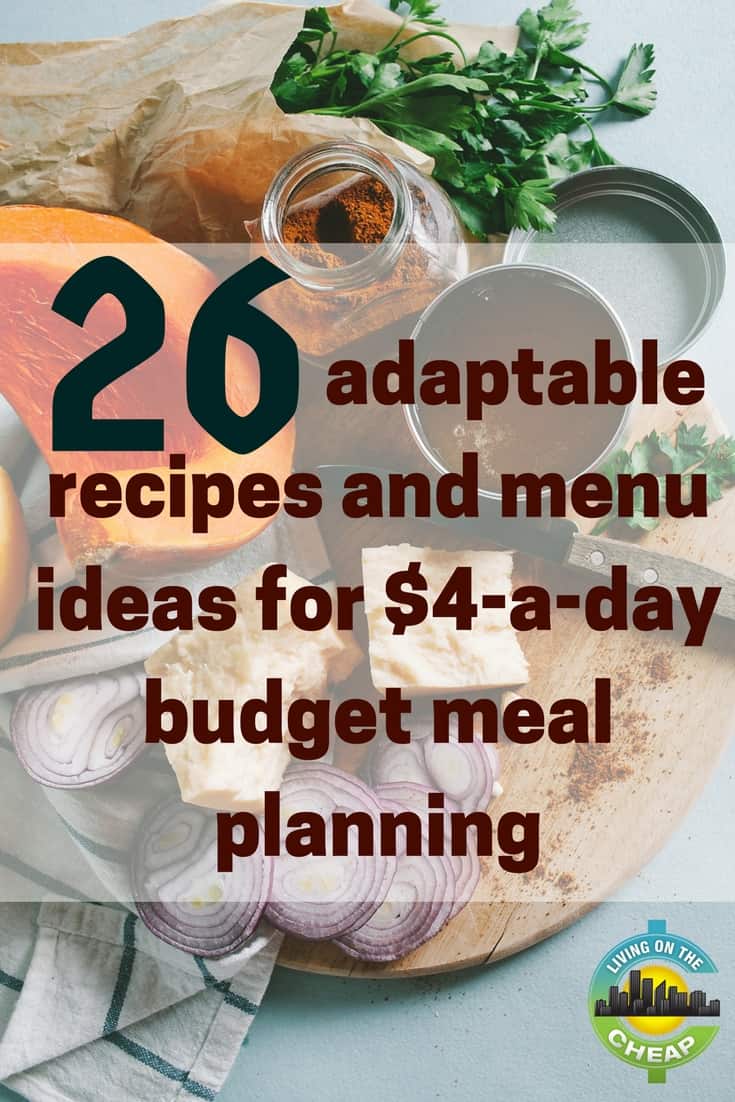
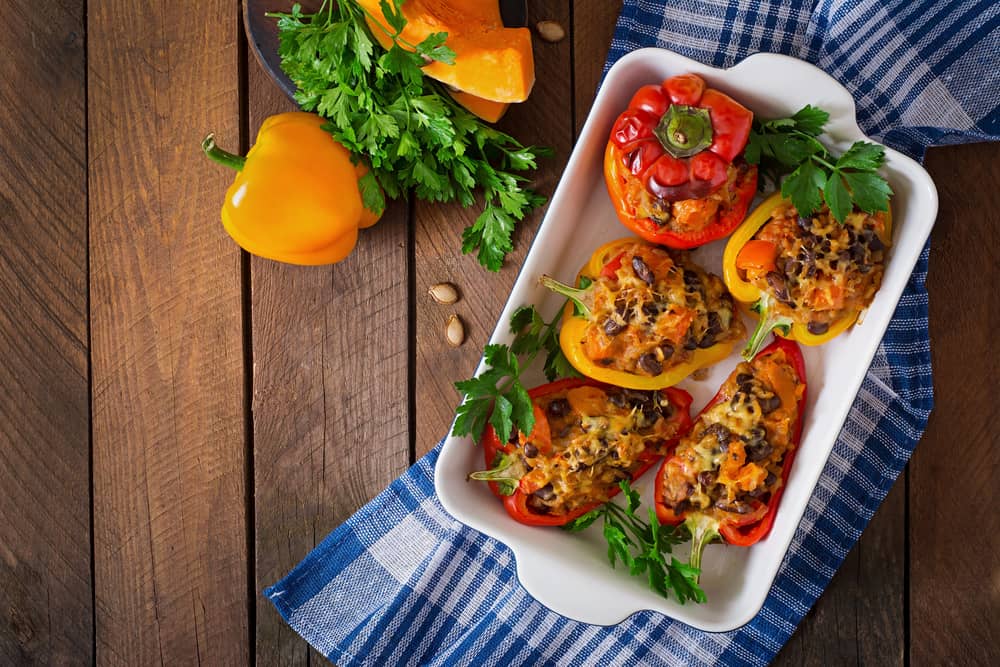 Tuesday: Taco filling ideas
Tuesday: Taco filling ideas
I have started a program where we have a “garbage salad” night ( everything I have that can be put into a salad); a smorgasbord night where we use up leftovers that are not enough for a whole meal for two in themselves, but I use up small leftovers and we “sample” leftovers; a pasta night; a sandwich night (which also can include certain leftovers) and always a fish night (when my husband has either shrimp or salmon, the only fish he likes, and I sometimes have cod fillets instead of the salmon). I also make stews and soups and roasts. I hate to waste food and I try to incorporate all of the products I buy so that nothing goes into the waste. We live on social security and a pension and it is important keep our food budget not only nutritional, but also within our dietary guidelines ( for various medical issues).